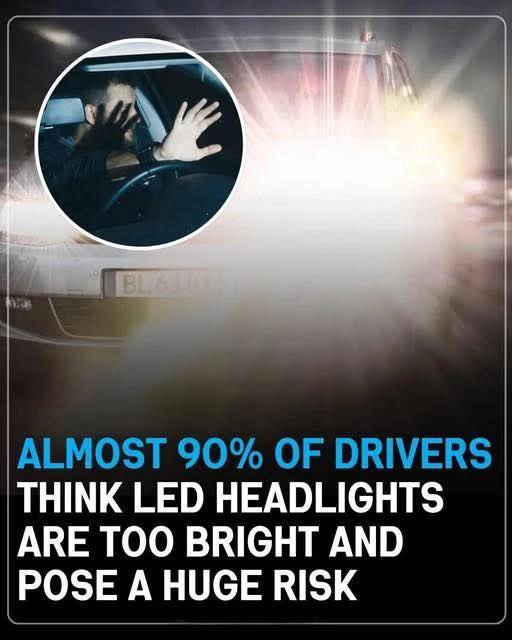LED headlights, now a common feature in modern vehicles, have become a flashpoint in ongoing discussions about road safety. Touted for their energy efficiency, longer lifespan, and sleek appearance, these lights are being embraced by automakers and consumers alike. Yet their increasing intensity and widespread use are raising alarm among drivers and safety experts. For many, what was once seen as a technological advancement is now considered a source of discomfort—and in some cases, danger.
A growing number of drivers report feeling temporarily blinded or distracted by the brightness of LED headlights, particularly during nighttime driving. In a recent national survey, nearly 90% of respondents agreed that LED headlights are too bright. This overwhelming sentiment highlights a widespread concern: while these lights may improve visibility for the driver behind the wheel, they can create serious challenges for oncoming traffic and those driving in lower-profile vehicles.
The core of the issue lies in how LED headlights function. Unlike traditional halogen bulbs that scatter light more diffusely, LEDs produce a highly focused, intense beam. This focused light can improve clarity for the driver using them, but it also increases the risk of glare for others. When improperly aligned or installed through aftermarket kits, the lights can shine directly into the eyes of oncoming drivers, causing brief but potentially dangerous moments of disorientation. These issues are particularly pronounced when high-riding vehicles such as trucks and SUVs direct their lights toward smaller sedans or motorcycles, making the contrast in height a key factor in glare-related complaints.
Despite these challenges, not all LED headlights are inherently problematic. Experts clarify that many of the complaints stem from misaligned headlights, non-compliant aftermarket installations, or a mismatch between vehicle design and lighting systems. Properly manufactured and factory-installed LEDs typically meet regulatory standards and are less likely to cause issues when correctly aimed. Still, the increasing number of complaints has led to growing calls for improved oversight.
Safety advocates and transportation authorities are urging lawmakers and regulatory bodies to address the problem more aggressively. Proposed measures include stricter alignment standards for headlights, brightness thresholds, and mandatory testing during vehicle inspections to ensure compliance. These actions aim to prevent excessive glare without stifling the benefits of newer lighting technology. Some countries are already exploring adaptive lighting systems that automatically adjust beam direction and intensity based on surrounding traffic, providing a potential solution that balances visibility with safety.
In the meantime, drivers are encouraged to take proactive steps. When upgrading headlights, it’s essential to choose products that meet safety standards and are compatible with the vehicle’s design. More importantly, headlights must be properly aimed to avoid unintentionally endangering others. For those experiencing glare from oncoming traffic, defensive strategies such as looking slightly to the right of the road or using the vehicle’s day-night mirror setting can help reduce discomfort during night driving.
As the conversation around LED headlights continues, it’s clear that technology alone doesn’t guarantee safety. Proper implementation, responsible use, and up-to-date regulations are critical in ensuring that advancements enhance rather than undermine the driving experience. The goal should remain simple: to provide better visibility for all road users, not just those behind the brightest lights.


